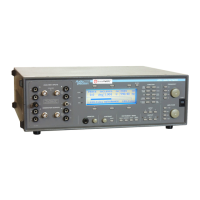600 Ω. If you are using a load with a different impedance, the power
calculation will not be correct. The generators source impedance is
included in the calculation, so if you change the source impedance of
the analog generator, it will change the output voltage of the analog
generator.
Part of the analog generator’s source impedance is shared between the
two channels, so this must be included in the dBm calculations. Any
channels that are turned on for generation are assumed to be loaded
with the specified impedance. For proper amplitude calibration, make
sure that any generator channels which are turned on are also loaded.
Controlling the Analyzer
Analyzer Overview
The ATS-1 Access analyzer is generally configured for only one type of
measurement at a time. The type of measurement currently being
displayed is determined by the current measurement function. Often a
single measurement function will provide measurement of several
related parameters.
The ATS-1 Access analyzer provides the following measurement
functions:
.
Amplitude with high and low pass filters, weighting filters (single
channel), and 1/3-octave bandpass filter
.
Level (two channels simultaneously)
.
Noise or signal-to-noise ratio (wideband, weighted, or selective)
.
THD+N (total harmonic distortion plus noise)
.
Interchannel phase and input-to-output phase shift
.
Real-time two-channel amplitude ratio (interchannel balance or
device gain/loss)
.
Real-time frequency-selective crosstalk
.
Wow and Flutter
.
SINAD (ratio of {signal + noise + distortion} to {noise +
distortion})
& For a more
detailed description
of the dBm unit, see
page 3-20.
3 Operation
Operational Overview Controlling the Analyzer
ATS-1 Access User's Manual 3-15

